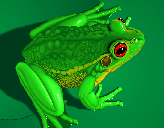|

|
Activity Four: There are a variety
of different types of interactions between two types of
living organisms. The basic types are summarized below. This
activity will require that you examine your biobottle, the
internet, and/or your local environment for evidence of each
of the different types of interactions described
below.
- Competition: In an ecosystem
factors such as food, water, and space are found in
limited quantities. Competition is the struggle among
organisms for limited resources. When organisms compete
with members of their own species, it's called
intraspecific competition. When organisms compete with
other species, it's called interspecific
competition.
- Predation: Organisms that eat
other organisms are predators. The organisms they eat are
prey. Predators and their prey coexist in a a balanced
relationship that keeps the population relatively
constant year after year.
- Symbiosis: A symbiotic
relationship is a permanent, close relationship between
two organisms of different species that benefits at least
one of them. The three types of symbiosis are described
below:
- Mutualism: A symbiotic
relationship in which two organisms live together or
cooperate with each other for mutual benefit. A lichen is
an example of this type of relationship. Lichens are
composed of an alga and a fungus intertwined with one
another. The alga produces sugar for itself and the
fungus. The fungus gets its food from the alga and
provides the alga with a protective cover and moisture so
it doesn't dry out.
- Commensalism: This is a type
of symbiotic relationship in which one of the two
organisms benefits and the other is neither helped nor
harmed. The orchid growing on a tree is an example, so is
a birds' nest in a tre branch. The trees aren't harmed or
helped but the orchid and the bird do benefit from the
relationship.
- Parasitism: This is a
symbiotic relationship where one organism benefits and
the other is harmed. In this type of relationship a
parasite lives in or on another organism called the host.
The host suffers some degree of harm as a result. An
example of a parasitic relationship is a tapeworm in a
dog or athletes foot fungus growing between your
toes.
Examine your biobottle closely and
look for any evidence of interrelationships between the
organisms living there. If you are unable to observe
examples of these types of interactions in your biobottle,
look around your outdoor environment or on the internet for
examples. In the space below list the organisms involved and
name the type of interrelationship. (Note: Room C-8 has a
variety of biobottles you could observe as well as many
additional resources for completing this activity. Come on
in!)
In the space below, give one example of
each type of interaction that you were able to discover (use
different examples than I did in the descriptions). Describe
the relationship, list the location where it was found, and
name the type of relationship.
|


